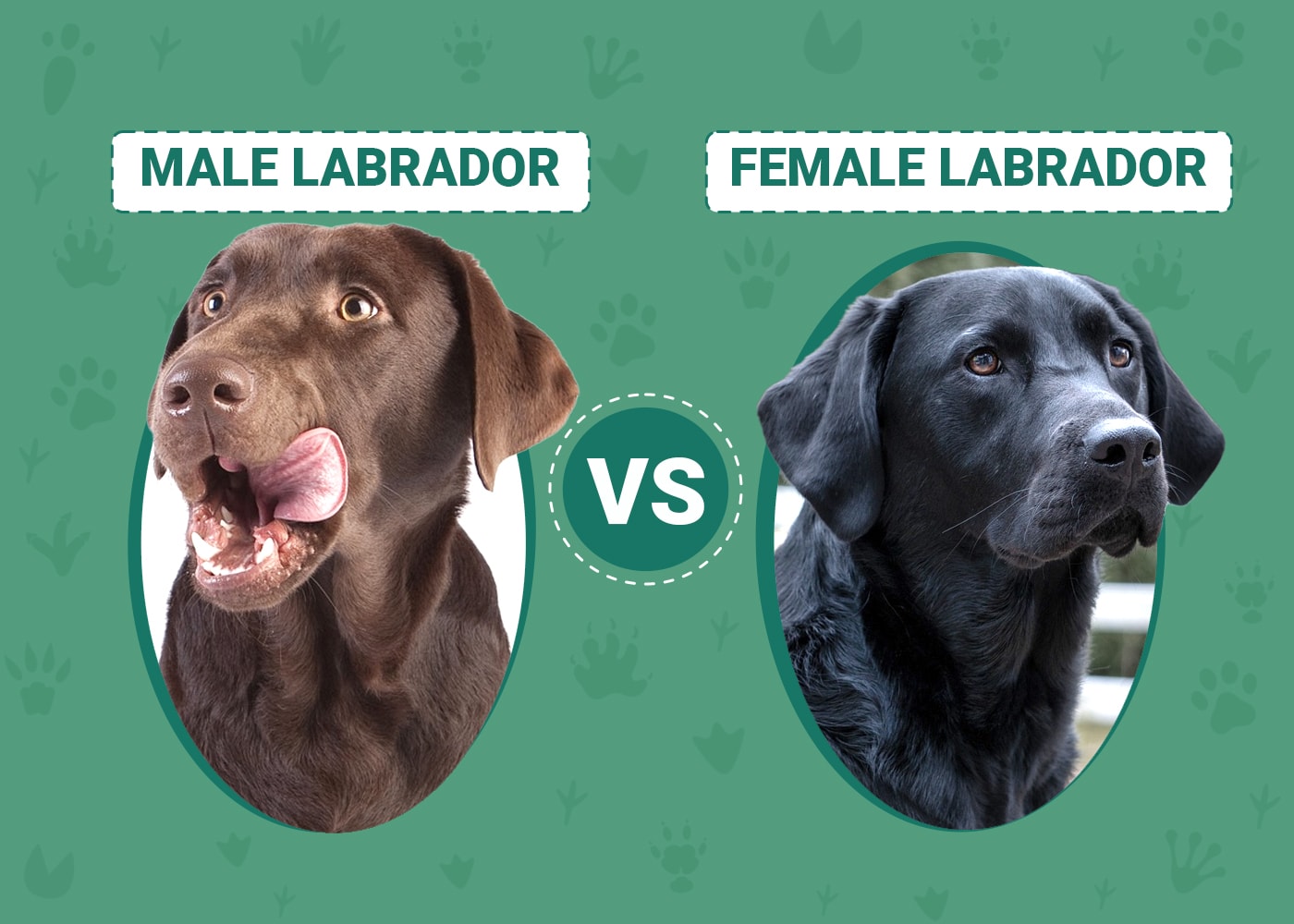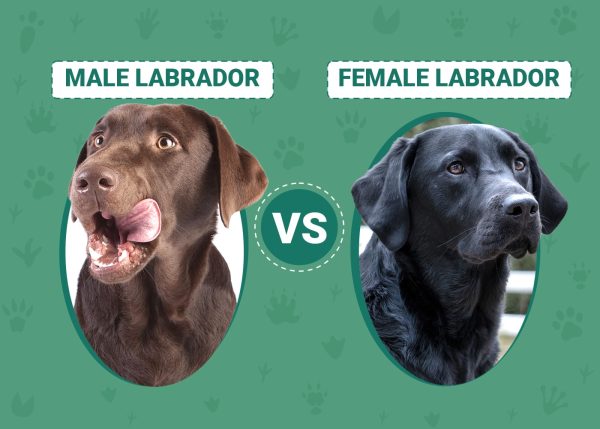Click to Skip Ahead
Whether chocolate, black, or yellow, Labradors have a friendly and loving nature that makes them a popular choice for families. Once you decide on a Lab and its color, you’ll need to choose between a male or female dog. Is one better than the other? Is there any significant difference?
The differences between a male and female Lab may be minor, but they could have a big influence on your decision. Find out what you should consider when choosing the sex of your Labrador.
Visual Differences

At a Glance
- Average height (adult): 22½–24½ inches
- Average weight (adult): 65–80 pounds
- Average height (adult): 21–23 inches
- Average weight (adult): 55–70 pounds
Labradors 101

Claiming one of the top spots in American Kennel Club’s Top 10 Most Popular Dogs, Labrador Retrievers are fun, sweet, and gentle dogs that are ideal for families with kids. They’re also a highly intelligent breed and an excellent hunting companion, especially for small game. The breed originated in the UK and was developed from Canadian fishing dogs as a gundog, meaning that it was bred to assist hunters in finding and retrieving game.
These medium-to-large dogs are gentle giants with a dense, hard coat that can be a deep black, rich chocolate, or vibrant yellow. One of the best features of the Lab is its eyes, however, which radiate calmness and intelligence. Labs tend to get along with all family members–human and animal alike–and enjoy energetic activities like swimming, fetch, and hunting. Whether you’re choosing a lab as a hunting assistant or a friendly family companion, this loyal breed is up to the task.
Male Labrador Overview

Personality
Both male and female Labs are loyal, gentle, kind, and intelligent. Of the few differences in the sexes, males are usually more playful and goofier, more attention-seeking, and more social with people and other pets. Some males may have a higher drive to please their owners. Males tend to be more protective of the family or the territory.
Training
Labs are easy to train compared to other breeds, but male Labs get distracted easily and may be harder to train than females. They’re also harder to housebreak, especially if they’re not neutered early and share a home with other intact males or intact females. Males also need more maintenance and consistency in reinforcing training behaviors.
Health & Care
Male Labs are prone to reproductive diseases like testicular cancer and prostate disease, especially if they aren’t neutered or are neutered after reaching sexual maturity. Males may also experience perianal tumors and hernias in old age. Be sure to speak to your vet about the best time to neuter your Lab to reduce the risk of these conditions.

Breeding
Male Labs reach sexual maturity at around 1 year old. At that time, the male may relentlessly seek a female for mating, which may include humping furniture, toys, and people. Intact males may also display sexually-based aggression or marking behaviors to establish and protect their territory.
- Playful
- Protective
- Harder to train
- Easily distracted

Female Labrador Overview

Personality
Female Labs are easygoing, gentle, and friendly like their male counterparts. Females may be more subtle in their displays of love and affection, however, and show dominance with “mannerly” behaviors like nudging or pushing. Female Labs are typically docile but may show aggression toward other female dogs, especially of similar age and size.
Training
Females mature faster than males, so female Labs are usually easier to train in the puppy stage. They’re also faster to house train and less likely to have setbacks, like accidents. This is due, in part, to the female’s sensitivity and attentiveness to the owner’s voice, which allows them to listen and retain the information more effectively.
Health & Care
Female Labs are prone to urinary tract infections, due to the way they position themselves to urinate. Most females squat low to the ground, introducing bacteria into the urethra. This can be managed with medication and lifestyle changes, such as a prescription diet. Female Labs are also susceptible to reproductive cancers, such as uterine, ovarian, and mammary cancer, if they’re spayed late or not spayed at all. If you don’t intend to breed, it’s best to spay your female before she reaches sexual maturity.

Breeding
Female Labs reach sexual maturity before males, at around 7 to 12 months. Females typically go into heat twice a year, which includes symptoms like swollen breasts, increased thirst, neediness, clinginess, excessive urination, and tail-flagging to attract a male. If you have a male dog, it may follow the female around in an attempt to mate.
- Quick to train
- Docile
- Aggressive toward females
- Prone to urinary tract infections
Which Labrador Is Right For You?
While there may be subtle differences in the male and female Lab, overall, these two sexes share the intelligence, gentleness, and friendliness that Labradors are known for. If you want a playful and goofy companion that acts as a guard dog, you may prefer a male. If you value quick training and a more subtle personality, the female may be the right choice. No matter which you choose, you’re sure to have a wonderful experience with this popular family dog breed.
Featured Image Credit: Top – kellyzoe, Pixabay | Bottom – Mylene2401, Pixabay










